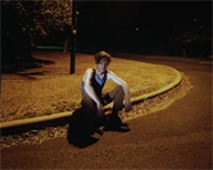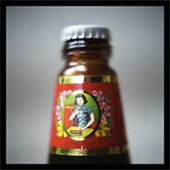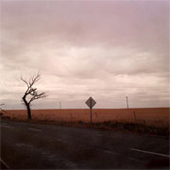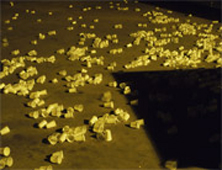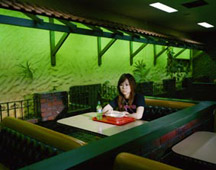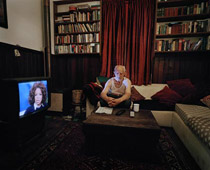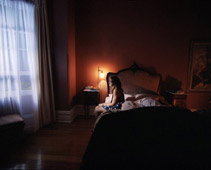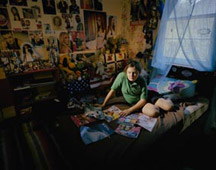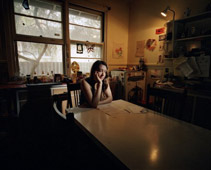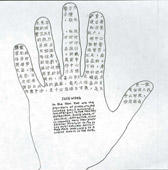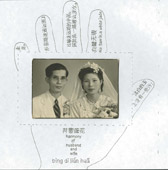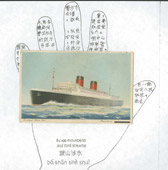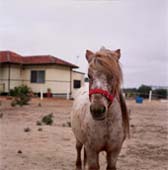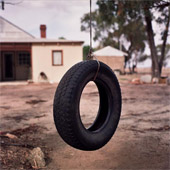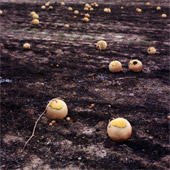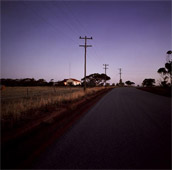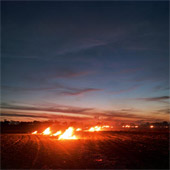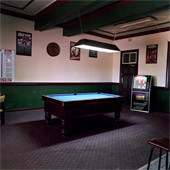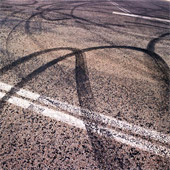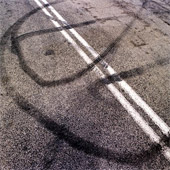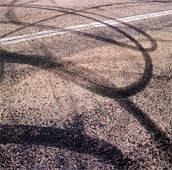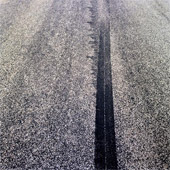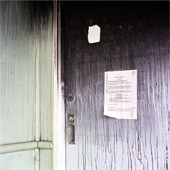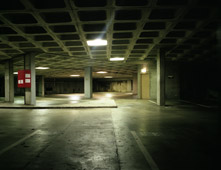|
|
|
|
BETWEEN A BLINK AND RECOGNITION Photography is not a purist, exclusively mechanical process of recording and representing reality. Like other artistic modes of expression it conveys an illustration, an allusion or a suggestion of it. An artistic medium greatly receptive to new ideas and cross-pollination between scientific and technological advancements, it maintains the ability, through the active exercise of the photographer’s insight, to challenge and update contemporary channels of communication. Photographic images have the inherent capacity to interweave and compress multiple narratives much like a series of actions projected so rapidly that the eye integrates them into a single frame. Only through the process of disengaging with the whole image and re-engaging with its single parts does meaning{s} evolve and intensify. The exhibition BETWEEN A BLINK AND RECOGNITION contemplates the interval between image and meaning; a pause unconstrained by time, geography or experience, where the space between a blink and recognition remains changeable like a magical theatre that keeps reinventing itself. Thematically the subject stretches from the magical and melancholic suburban theatre to secret dialogues of hidden urban realities, rural myths and social landscapes as well as the idiosyncrasy of cultural dispersion. The thread that binds the selected works is neither literal, narrative or stylistic. It is a ‘quietness’, an underlying pause that briefly surfaces to link vision and perception. MAX PAM’S images witness the shifting human condition. His work is piercingly intuitive. In The Chinese Diaspora {1970-2004} the photographer is present through text, image and presentation as both observer and ancillary participant, diaristically involved in each image and their sequences. There seems to be an underlying relationship between photographer and subject, and photographer as subject that involves a reflective and unobtrusive anthropological voyeurism intended as a means to understand one’s own dimension in the world. The Chinese Diaspora {1970-2004} documents the lives of the hua-chiao, the ‘sojourning’ Chinese of South East Asia. This is an important distinction, these people are colonists who are not quite settlers, their distinctiveness, and their unique identity within their host culture is defined by their untarnished cultural and ritualistic tie to their ancient Chinese traditions. This narrative exemplifies a myriad of similar experiences where racial specificity, traditional values and ancient customs remain active and retain strict historical conventions outside their country of origin, where often such practices are long forgotten or have been diluted and adapted to conform with contemporary culture. These are personal stories, steeped in reverence for a past that no longer exists. Memory is fleeting, shifting, yet enduring and concrete, it is part of the process through which we try to understand and make sense of our times. The Chinese Diaspora portrays a cultural diorama. Here a controlled social consciousness closes the emotional gap between the memory of the past and the reality of the present, the need to relate to the world according to culturally personal and ethnic idioms in an attempt to maintain certainties about identity and one’s place in a new world. Memory and cultural idiosyncrasies inform the works by BRAD RIMMER. The memory of growing up in rural Australia, the quietness and remoteness of the landscape, the isolation of being left with your own thoughts and the silence of the unspoken word. The image often shot from behind the glass of the car window frames a formal landscape, seemingly unmovable, scarred by the unceasing obliteration of history and the natural world by progress. A romantic quasi-idyllic reflection of the landscape maintains a reverent stillness and a sense of impermanence, a metaphor of human existence subsisting within it. The series Silence alludes to the shifts in rural expansion and its demise, the changes in social structures when the advent of the car, transport and better road infrastructures opened the way for new experiences. Where the once insular town has slowly lost its youth, its lifeblood and now exists as a residue of memory. Through contemplative and introspective images, Brad Rimmer searches for the recognisable elements that shape the region and its people. He questions the ‘familiar’ beauty of our environments gently scrutinizing Australia’s perception of itself, affirming that our cultural identity is based on empathy and understanding of our environment and the indelible binary link we have with it. GRAHAM MILLER’S images sashay on the periphery of a magic People are portrayed in isolated moments, inaccessible and remote. The flicker of a moment in time, fleeting and immaterial is charged with contrived importance to refocus our attention on the characters. It beckons our attention with paramount importance. The event that leads to this image is inconsequential, what is significant is its ambiguous silence and that illusive narrative that begins… “who are these people and what has happened here?”. The images through their polished veneers, confess and conceal, they are as much naked as they are shrouded. Each is a perfect blend of sharp visual dramatisation and poignant psychological analysis. The spectator becomes caught in an unfamiliar dialogue, shifting layers of meanings, multiple plots and consequences. The irony lies in the fact that while the images are contrived and artificial, the bitter truths they invoke are piercing, insightful and very real. BEN SULLIVAN depicts locations that we rarely pay much attention to, the architecture of urban silence. Images of inner-city nightlife, the unperceived singularity of commonplace constructions and locations. These environmental portraits focus on the formal beauty of urbanity. The images are shavings of a larger picture; their large size is inherently part of its quasi industrial, large scale subject matter. These nighttime subjects are captured in a moment of quiet reflection, where human activity has ceased and a temporary passiveness envelops the scene. Where the unperceived and the unsuspected run like currents through the works. The silence however is not momentary but enduring. The humdrum of day time routine has temporarily come to an end and these locations take on a lingering reverence. While this subject matter is usually invisible to us on a daily basis, an undefined and anonymous backdrop to our comings and goings, here it takes on a majestic and central importance. Elements within each image, the reflection of a pool of water, the ambiguous light inside a closed building, scattered cups, all attest to a transitory time between past and future, presence and absence. These works document the physical, temporal and conceptual space between what was and what will be and leave us to fill in the imaginary gap.
PDF DOWNLOADS > BRAD RIMMER CV
*All photographs are printed in archival pigment. *prices valid 2005
|
- TURNER GALLERIES | showcasing contemporary art
at 470 WILLIAM STREET NORTHBRIDGE WESTERN AUSTRALIA 6003 - TURNER GALLERIES HAS NOW CLOSED.
This website is an archived record of the exhibitions and artwork shown at the gallery. - Turner Galleries acknowledges the Whadjuk Nyoongar people as the Traditional Owners of the lands and waters where Turner Galleries is situated, and pay our respect to Elders past, present and emerging.
- Website © 2000-2024 TURNER GALLERIES. All images are © the artists and are not to be used without permission.
- This is a millapede project.


